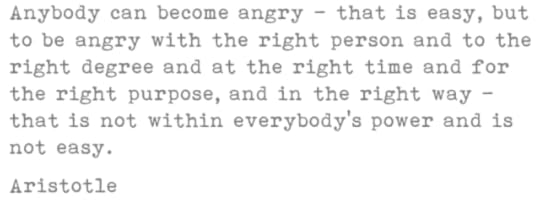Andrew Furst's Blog, page 134
April 22, 2015
Verse Us – Spring – A Composite Poem
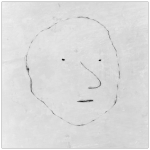 Verse Us - Poems I write: haiku, senryu, mesostics, free verse, random word constructions, I might even use rhyme or meter once and a while.
Verse Us - Poems I write: haiku, senryu, mesostics, free verse, random word constructions, I might even use rhyme or meter once and a while.
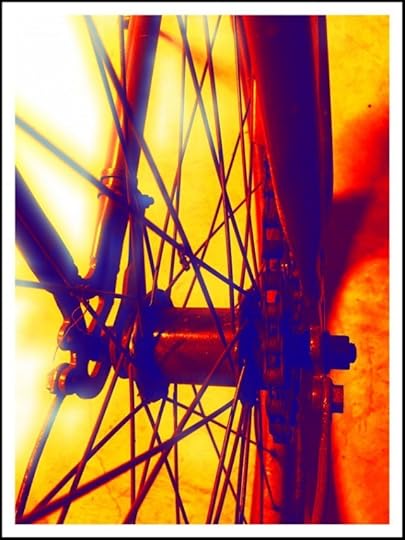
Stand forth
sweet sleeping flowers.
First hours waiting like a child, then leaping.
Hands, eyes, spirit climb
Swift veins carry young love.
Much comes;
sky, clouds, stars, grass, everything.
Whoever is searching,
go deep.
Prowl soil and clay.
Look, sniff, bring ear and mind
Come boy, outside.
Twilight’s flickering flames.
Feel the wild lilies dream quiet.
April carefully kisses
our emerald, blue earth.
This composite poem was constructed using the text of several poems on spring (listed below). I used Wordle to select out the most frequently used words in the poems. From these words I built this poem.
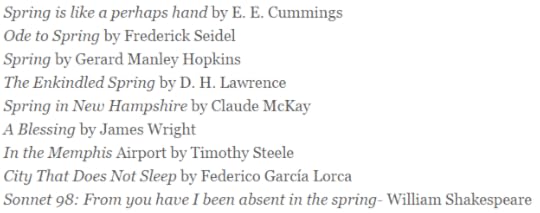
Get Each Week's Verse Us in your email box
First Name:
Last Name:
Email address:
In addition to a monthly email you can also subscribe to the following weekly series:
One Minute Meditations
Tiny Drops (Photography series)
Compass Songs (My Favorite Poems)
Dialectic Two-Step
Modern Koans (interesting questions)
Sunday Morning Coming Down (Music Videos)
Relics (Timeless Republished Articles)
Say What?
Quotes
Verse Us (Poems I Write)
The post Verse Us – Spring – A Composite Poem appeared on Andrew Furst.
Tiny Drops – Uncommonly Common
 Tiny Drops is an ongoing iPhoneographic series. The images represent moments of noticing on my part. For you, they are an offer to pause, observe, and take that noticing into your life. All photos are mine unless noted otherwise.
Tiny Drops is an ongoing iPhoneographic series. The images represent moments of noticing on my part. For you, they are an offer to pause, observe, and take that noticing into your life. All photos are mine unless noted otherwise.
 These works by Andrew Furst are licensed under a Creative Commons Attribution-NonCommercial-ShareAlike 4.0 International License.
These works by Andrew Furst are licensed under a Creative Commons Attribution-NonCommercial-ShareAlike 4.0 International License.
Click on images to view the full size slide show.
 bowling ball return 3 filter
bowling ball return 3 filter breakfast
breakfast church windows
church windows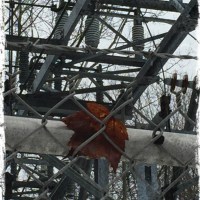 left behind
left behind pool
pool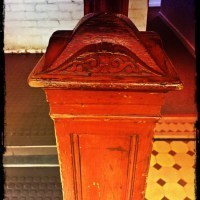 stair postGet Each Week's Tiny Drops in your email box
stair postGet Each Week's Tiny Drops in your email boxFirst Name:
Last Name:
Email address:
In addition to a monthly email you can also subscribe to the following weekly series:
One Minute Meditations
Tiny Drops (Photography series)
Compass Songs (My Favorite Poems)
Dialectic Two-Step
Modern Koans (interesting questions)
Sunday Morning Coming Down (Music Videos)
Relics (Timeless Republished Articles)
Say What?
Quotes
Verse Us (Poems I Write)
FIVE LIMITLESS THOUGHTS
May all living beings have happiness and its causes
May all be free from unhappiness and its causes
May all dwell in equanimity, free of attraction and aversion
May all quickly find the great happiness that lies beyond all misery
May all enjoy inner and outer peace now and forever
NAMO AMITOFOThe post Tiny Drops – Uncommonly Common appeared on Andrew Furst.
April 21, 2015
Say What? – Where Am I?

Say What? is an ongoing series of laconic exchanges on Buddhism in the format of a comic strip.
This shirt is dry clean only. Which means... it's dirty. - Mitch Hedberg
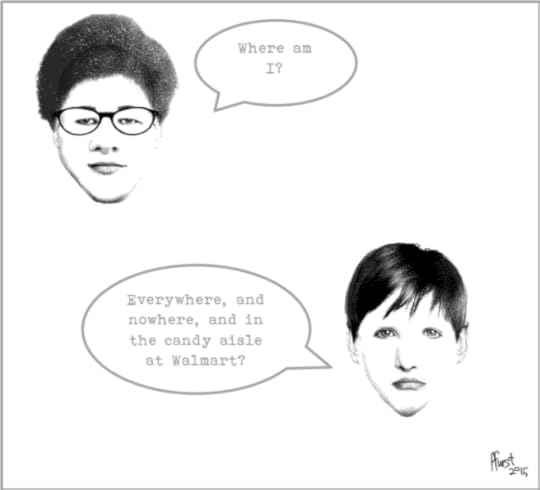
Where am I?
Get Each Week's Say What? in your email box
First Name:
Last Name:
Email address:
In addition to a monthly email you can also subscribe to the following weekly series:
One Minute Meditations
Tiny Drops (Photography series)
Compass Songs (My Favorite Poems)
Dialectic Two-Step
Modern Koans (interesting questions)
Sunday Morning Coming Down (Music Videos)
Relics (Timeless Republished Articles)
Say What?
Quotes
Verse Us (Poems I Write)
The post Say What? – Where Am I? appeared on Andrew Furst.
Compass Songs – Satchmo
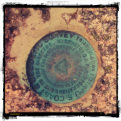 Compass Songs is an ongoing series of works by poets that I enjoy. Poetry, as the Zen Masters have said, is like a finger pointing to the moon. It speaks the unspeakable.
Compass Songs is an ongoing series of works by poets that I enjoy. Poetry, as the Zen Masters have said, is like a finger pointing to the moon. It speaks the unspeakable.
King Oliver of New Orleans
has kicked the bucket, but he left behind
old Satchmo with his red-hot horn
to syncopate the heart and mind.
The honky-tonks in Storyville
have turned to ashes, have turned to dust,
but old Satchmo is still around
like Uncle Sam’s IN GOD WE TRUST.
Where, oh, where is Bessie Smith,
with her heart as big as the blues of truth?
Where, oh, where is Mister Jelly Roll,
with his Cadillac and diamond tooth?
Where, oh, where is Papa Handy
With his blue notes a-dragging from bar to bar?
Where, oh where is bulletproof Leadbelly
with his tall tales and 12-string guitar?
Old Hip Cats,
when you sang and played the blues
the night Satchmo was born,
did you know hypodermic needles in Rome
couldn’t hoodoo him away from his horn?
Wyatt Earp’s legend, John Henry’s, too,
is a dare and a bet to old Satchmo
when his groovy blues put headlines in the news
from the Gold Coast to cold Moscow.
Old Satchmo’s
gravelly voice and tapping foot and crazy notes
set my soul on fire.
If I climbed
the seventy-seven steps of the Seventh
Heaven, Satchmo’s high C would carry me higher!
Are you hip to this, Harlem? Are you hip?
On Judgment Day, Gabriel will say
after he blows his horn:
“I’d be the greatest trumpeter in the Universe
if old Satchmo had never been born!”
First Name:
Last Name:
Email address:
In addition to a monthly email you can also subscribe to the following weekly series:
One Minute Meditations
Tiny Drops (Photography series)
Compass Songs (My Favorite Poems)
Dialectic Two-Step
Modern Koans (interesting questions)
Sunday Morning Coming Down (Music Videos)
Relics (Timeless Republished Articles)
Say What?
Quotes
Verse Us (Poems I Write)
The post Compass Songs – Satchmo appeared on Andrew Furst.
April 20, 2015
Dialectic Two Step – Emptiness & The Dairy Queen Moon
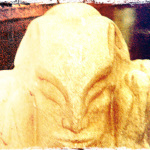 Dialectic Two-Step is an ongoing series of my thoughts on questions that come my way.
Dialectic Two-Step is an ongoing series of my thoughts on questions that come my way.
Wisdom lies neither in fixity nor in change, but in the dialectic between the two. - Octavio Paz
EmptinessThe photo above is of the full moon eerily glowing through the trees. Out of context, the image looks dark and foreboding. But, in fact, I snapped the shot on a bustling Saturday evening at the local Dairy Queen. Not what you might expect.
Relationships can be the same way. They’re not always what they seem. Knowing what goes on in the mind of others is basically impossible. While we can read our partners by their body language and tone of voice, our reads are unreliable. Oddly, the mystery and ambiguity of the “other minds” problem is a clue to the meaning of the Buddhist concept of emptiness.
Emptiness is profound. It can open the door to an intimate understanding of the nature of being. Meditating on emptiness can be a life changing experience. But as complicated as it sounds, its roots lie firmly in our day-to-day experience.
The Heart Sutra tells us enigmatically:
There is no wisdom, and there is no attainment whatsoever.
Here’s my take.
When we look for wisdom, we discover that it is hard to find.
What if I asked you to name the wisest person. Would it be Jesus? How about Confucius? Maybe Martin Luther King, Stephen Hawkings, or Ronald Reagan? Why is it so difficult? Somehow, you have to measure and compare wisdom. How do you measure it?
What Would God See?
 Here is the connection to the photograph of the moon. Standing in line at the Dairy Queen with my sons, I happened to look up to the sky and notice how remarkable the moon looked through the trees. I pulled out my iPhone and snapped a few shots and moved on.
Here is the connection to the photograph of the moon. Standing in line at the Dairy Queen with my sons, I happened to look up to the sky and notice how remarkable the moon looked through the trees. I pulled out my iPhone and snapped a few shots and moved on.
In the meantime, my boys were chatting about something and barely took notice. The experience of the moon was perhaps lost on them, but from their perspective the moon had no meaning or relevance. Whatever they were discussing was what mattered. Which perspective is correct? Which provides insight to the truth about the moment? If you dig deep into it, these questions really don’t make any sense.
Is there an ultimate perspective? Is there some point of view where the underlying meaning of all things is clear? From our vantage point, things only have meaning when we give it to them. Take it one step further. Often we see what we want to see, with only minor reference to our direct perceptions of them. Everything we see is through the prism of our moods and accumulated experiences. If we’re scared, we’ll see things as a threat. If we’re happy, we’ll take delight in them.
Werewolves Exist (In my mind)
 When I see a full moon, and my youngest son is with me, I think of werewolves. This, in and of itself, isn’t a unique perspective, but dig deeper, and the color that my memories add to the experience makes it one of a kind. When he was very young, he was extremely scared of werewolves. So much so that we avoided talking about the full moon to keep from frightening him. I can picture the look on his younger face, the house where we lived, and a whole host of things unique to my experience.
When I see a full moon, and my youngest son is with me, I think of werewolves. This, in and of itself, isn’t a unique perspective, but dig deeper, and the color that my memories add to the experience makes it one of a kind. When he was very young, he was extremely scared of werewolves. So much so that we avoided talking about the full moon to keep from frightening him. I can picture the look on his younger face, the house where we lived, and a whole host of things unique to my experience.
Of course, your experience of a full moon will be different from mine, even if we stood next to each other taking in the same view. In those differences can lie an infinitude of meanings. Yet none of those meanings belong to the objects of our perceptions. If we take this line of thinking to its conclusion, we’ll discover that all form and meaning is held in our minds.
What makes the moon the moon? Imagine it through the eyes of a newborn child. The baby has no concept of the moon. On noticing the shape in the sky, she inquires by pointing. There is no word for her, there is only light. Her mother tells her, “that’s the moon sweetie”. This is the first meaning – the first form – of the moon taking shape in the little girl’s mind. The world does not create or hold any ideas about itself. This is what is meant by emptiness. The objects of our perceptions are empty of inherent existence.
form is no different to emptiness,
emptiness no different to form.
Yeah, but….
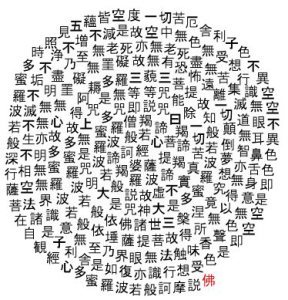 Is this all just obscure psycho-babble or can we use this little insight on emptiness to improve our relationships and quality of life?
Is this all just obscure psycho-babble or can we use this little insight on emptiness to improve our relationships and quality of life?
Actually, to many, the idea of emptiness is considered heresy and an impediment to a good life. It is a relativistic view that undermines absolutes, particularly morality. Emptiness implies that right and wrong are fuzzy and situational. Welcome to the chewy center of human relationships. Welcome to reality.
The Heart Sutra is one of the most cherished Buddhist scriptures. It is also one of the most challenging. Its mind-boggling. Just look at some of the passages
[things] are neither appearing nor disappearing,
neither impure nor pure,
neither increasing nor decreasing
[there is] no ignorance and no end of ignorance,
up to no aging and death,
and no end of aging and death;
 Things don’t exist? Can we walk through walls because everything is an illusion? Does that mean its a moral free for all? No.
Things don’t exist? Can we walk through walls because everything is an illusion? Does that mean its a moral free for all? No.
This interpretation fails the Buddha’s prime directive, which is try it out and see if it works in experience. We understand right and wrong. We know that walls require doors to walk through them. So what is this enigmatic scripture trying to tell us?
Avalokitesvara Bodhisattva, the speaker in this Sutra, is telling us where form and meaning come from. They reside in our minds. Morality is born at the crash site where our minds and reality collide. Right and wrong distinguish good and bad strategies for survival, social cohesion, and contentment. We develop morality by piecing together our experience and the advice of others who’ve learned the hard way. It doesn’t exist outside of our minds in any pure state. Take the example of wisdom I used before. There is no objective measure of wisdom that we can apply to determine who has the most. The concepts of wisdom and morality are subjective.
Yeah, but….
How does this understanding help us?
It gives us a clue about how to approach being in relationships. If right and wrong is relative, than how right can you be in an argument with your partner? If I’m scared of the moon because it reminds me of werewolves, where is the root of fear? In the Moon? No, it’s in my mind.
If someone else is afraid of something, how valuable is it for you to try and convince them that they shouldn’t be? If you recognize that the fear lives in that persons mind, and that it is the result of accumulation of negative experiences, it is instructive. It would allow you to approach the problem in a more compassionate and validating way. Observe the difference:
I can’t believe you’re scared of the moon. Why would anyone be scared of the moon?
Wow, I didn’t realize you were scared of the moon, why is that?
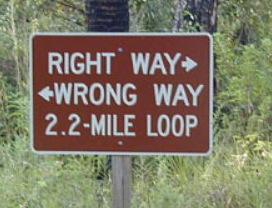 The Buddhist concept of emptiness offers a practical foundation for compassion in our relationships. Our view points are undeniably subjective. Ideas like I’m right and you’re wrong should be viewed in relative terms. The minds of others are shaped by their unique constellation of experiences. The preferences and aversions that arise from their life stories are the root of suffering. As we discover this for ourselves, we can also take away some important insights into our relationships. Buddhism calls these insights wisdom and compassion. The wisdom to see the source of our suffering and the compassion for others, because they suffer as we do.
The Buddhist concept of emptiness offers a practical foundation for compassion in our relationships. Our view points are undeniably subjective. Ideas like I’m right and you’re wrong should be viewed in relative terms. The minds of others are shaped by their unique constellation of experiences. The preferences and aversions that arise from their life stories are the root of suffering. As we discover this for ourselves, we can also take away some important insights into our relationships. Buddhism calls these insights wisdom and compassion. The wisdom to see the source of our suffering and the compassion for others, because they suffer as we do.
Watch It
But be careful with Emptiness. It is just a concept, and therefore in our head. Don’t let it confuse you or convince you that the world isn’t what we experience it to be. Look to emptiness as a tool, which can be put aside when we’re done with it. If we don’t need to drive any more nails, the hammer is no longer useful.
Get Each Week's Dialectic Two Step in your email boxThe victorious ones have said
That emptiness is the relinquishing of all views.
For whomever emptiness is a view,
That one has achieved nothing.”
― Nāgārjuna,
First Name:
Last Name:
Email address:
In addition to a monthly email you can also subscribe to the following weekly series:
One Minute Meditations
Tiny Drops (Photography series)
Compass Songs (My Favorite Poems)
Dialectic Two-Step
Modern Koans (interesting questions)
Sunday Morning Coming Down (Music Videos)
Relics (Timeless Republished Articles)
Say What?
Quotes
Verse Us (Poems I Write)
The post Dialectic Two Step – Emptiness & The Dairy Queen Moon appeared on Andrew Furst.
April 18, 2015
Say What? – The Meaning Of All This

Say What? is an ongoing series of laconic exchanges on Buddhism in the format of a comic strip.
This shirt is dry clean only. Which means... it's dirty. - Mitch Hedberg
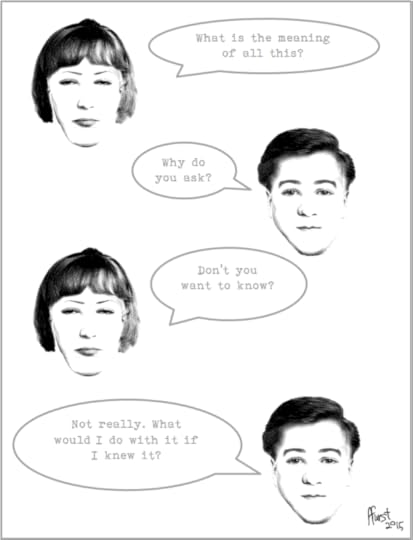
The Meaning Of All This.
Get Each Week's Say What? in your email box
First Name:
Last Name:
Email address:
In addition to a monthly email you can also subscribe to the following weekly series:
One Minute Meditations
Tiny Drops (Photography series)
Compass Songs (My Favorite Poems)
Dialectic Two-Step
Modern Koans (interesting questions)
Sunday Morning Coming Down (Music Videos)
Relics (Timeless Republished Articles)
Say What?
Quotes
Verse Us (Poems I Write)
.mc4wp-form input[name="_mc4wp_required_but_not_really"]{display:none !important}
The post Say What? – The Meaning Of All This appeared on Andrew Furst.
Meditation Techniques – Remembering Breath
Let me ask you, “Have you ever enjoyed a nice deep breath?” If you’ve spent anytime in a yoga or meditation class, you’ll know exactly what I’m talking about. If there ever was a magical elixir, a open and deep breath is it. It’s free and it holds the secret to millions of satisfying moments (you breathe on average about 5 million times a year). It doesn’t require practice, it doesn’t require special training.
Nobody’s an expert and nobody is exempt. So no excuses, join me now:
Ground yourself. Let your weight sink down. Into your chair, your feet, your back, wherever you are and what ever position your in, let your weight, tension and intention flow down. With that grounding feel yourself shed the weight of the day.Close your eyes.Breath in a little deeper than normal and allow the energy of the breath to descend all the way to your lower abdomen. Allow your belly to expand to accommodate.Exhale naturally, but fully.Breath in a little bit deeper, into the belly and let your lower rib cage expand a bit to allow even more air in.Exhale naturally, but fully, collapsing the belly and the ribs to expel as much of the air in your lungs as possible.Breath in deeply, into the belly, the entire rib cage, all the way up to your collar bones, letting the lungs fully take in the breath without resistance.Exhale fully, collapsing the belly and ribs to expel as all the air.Notice how you feel
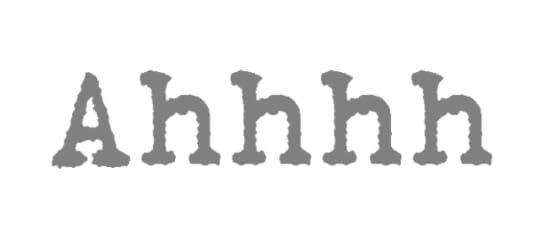
The post Meditation Techniques – Remembering Breath appeared on Andrew Furst.
April 17, 2015
Modern Koans – Can’t You See You’re Hurting Me?
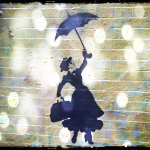 Modern Koans is an ongoing series that recognizes that good questions are often more important then their answers.
Modern Koans is an ongoing series that recognizes that good questions are often more important then their answers.
The riddles of God are more satisfying than the solutions of man. ― G.K. Chesterton
Can’t You See You’re Hurting Me?
Question: Why are pain and suffering transparent to those who distribute it?
Response: First, I don’t think it is always the case that pain and suffering is transparent to those who distribute it. I make decisions and ask people to do things that I know they won’t like. For instance I’ll tell my son to clean his room. He has an aversion to it, which I am acutely aware of, but I ask him to do it anyway.
For the cases where someone causes you to suffer and they seem oblivious, of course the answer is we cannot know what’s in the mind of others. If you suffer at the hand of someone else, you have some responsibility to communicate to them about it. Of course we have to weigh our decision to do so with the potential outcome. If you tell your boss that his demand that you do work causes you to suffer, you may loose your job.
Some people have extremely low empathy or are incredibly self-centered. Sometimes we may need to expel these people from our lives. In other cases we can begin a steady dialog.
For me, a good rule is to look at communication as one part message and one part relationship. If you forget one, suffering often follows.
So the questions:
What responsibilities do others have to prevent our suffering?
What do you do about people you have to live with who hurt you?
What power do we have to change anything?
Get Each Week's Dialectic Two Step in your email boxFirst Name:
Last Name:
Email address:
In addition to a monthly email you can also subscribe to the following weekly series:
One Minute Meditations
Tiny Drops (Photography series)
Compass Songs (My Favorite Poems)
Dialectic Two-Step
Modern Koans (interesting questions)
Sunday Morning Coming Down (Music Videos)
Relics (Timeless Republished Articles)
Say What?
Quotes
Verse Us (Poems I Write)
.mc4wp-form input[name="_mc4wp_required_but_not_really"]{display:none !important}
The post Modern Koans – Can’t You See You’re Hurting Me? appeared on Andrew Furst.
April 16, 2015
Aristotle on Anger
One Minute Meditation – Looking Over East Dover Bridge
 One Minute Meditations is an ongoing series of short videos, poems, and commentary intended as a meditation. Offered as an opportunity to step back from your cyber routine and settle into a more natural rhythm, if only for a minute.
One Minute Meditations is an ongoing series of short videos, poems, and commentary intended as a meditation. Offered as an opportunity to step back from your cyber routine and settle into a more natural rhythm, if only for a minute.
A year ago I wrote two pieces on Dragon Brook in Shelburne Falls. The meditations were on two views of the brook. The first saw the brook coming towards us. The second flowing away. Each offered a very different feel.
This is a view of the Piscataquis River flowing away. The breadth of the river at this point in East Dover is fairly impressive. The tug on the psyche is on a different order of magnitude than Dragon Brook.
We always color our perceptions with judgment. The receiving and loss I described in the Dragon Brook pieces are a perfect example.
My experience with this view is altogether different. The pull that I feel from the river is much more soothing. When I watch the movement of the water, I feel the subtle purifying power of the current. The river pulls on my heart like the tidal force of the moon. I can feel each quantum of tension dissolve into the space created between the river and me.
Meditation on MeditationWhat comes with sitting?
Or is it what we give up
Finding our spaces?
Get Each Week's One Minute Meditation in your email box
First Name:
Last Name:
Email address:
In addition to a monthly email you can also subscribe to the following weekly series:
One Minute Meditations
Tiny Drops (Photography series)
Compass Songs (My Favorite Poems)
Dialectic Two-Step
Modern Koans (interesting questions)
Sunday Morning Coming Down (Music Videos)
Relics (Timeless Republished Articles)
Say What?
Quotes
Verse Us (Poems I Write)
AboutLatest Posts[image error]Follow meAndrew FurstAuthor of the book Western Lights, Meditation Teacher, Buddhist blogger, Poet, yogi, backup guitarist for his teenage boys, lucky husband and technologist [image error]Follow meLatest posts by Andrew Furst (see all) Modern Koans – Can’t You See You’re Hurting Me? - April 17, 2015 Aristotle on Anger - April 16, 2015 One Minute Meditation – Looking Over East Dover Bridge - April 16, 2015
The post One Minute Meditation – Looking Over East Dover Bridge appeared on Andrew Furst.

